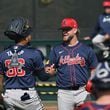The past three MLB drafts marked high points of those sad Braves’ seasons. When you’re tanking, you live for those three days in June -- because the quickest way a tanking team rises is to draft well.
Only one member of those three draft classes has reached the majors, and he’s on the disabled list. Still, Mike Soroka showed enough in three big-league starts to suggest he has the goods, and third baseman Austin Riley – the third player taken in Round 1 by the Braves in 2015, Kolby Allard and Soroka being the first two – has hit 10 homers this season between Double-A and Triple-A.
The Baby Braves’ nursery was populated by John Coppolella’s manic dealing – Mike Foltynewicz, Sean Newcomb, Dansby Swanson and Ender Inciarte came in trades – and the cultivation of assets inherited from the Frank Wren regime. (Meaning Ozzie Albies, Ronald Acuna and Johan Camargo, all signed via the international market.) Those successes aside, the chief reason Wren was “terminated” in September 2014 involved the draft whiffs on his watch.
The Round 1 picks under Wren: Brett DeVall, Mike Minor, Matt Lipka, Sean Gilmartin, Lucas Sims, Jason Hursh and Braxton Davidson. The Round 2 selections: Zeke Spruill, Tyler Stovall, Andrelton Simmons, Todd Cunningham, Nick Ahmed, Alex Wood, Victor Caratini and Garrett Fulenchek.
Simmons, traded to the Angels by Coppolella for a package that included Newcomb, is an All-Star and a perennial Gold Glove winner. Minor was a solid part of a playoff-caliber rotation until he got hurt; now with the Rangers, he’s 4-4 with an ERA of 5.76. Wood, sent to the Dodgers in the Hector Olivera deal, has had some big years (two here, another with L.A. last season); he’s 1-4 with a 4.48 ERA now. Shipped to Arizona by Wren in the Justin Upton swap, Ahmed is a starting shortstop of no great distinction.
Even if we throw in Craig Kimbrel – a Round 3 pick in 2008 – that’s not a bountiful return for seven drafts. (In 2007, the last draft under John Schuerholz, the Braves’ first two picks were Jason Heyward and Freddie Freeman.) There’s a reason that, by 2014, this farm system was regarded as among the five worst. There’s a reason Coppolella and John Hart, as commissioned by Schuerholz, launched their massive rebuild. To get younger, cheaper and ultimately better, the Braves first had to get worse.
Holding a 1 1/2-game lead in the National League East a week after Memorial Day tells us that the reset has worked. Good now, the Braves should get only better. Counting Acuna and Camargo, four of the everyday eight are under 25. Freeman is 28 and under contract through 2021; Inciarte, 27, and under contract through 2022. If we include Soroka as the No. 5 starter, four members of this rotation are 27 or younger – and MLB Pipeline lists eight more pitchers among the Braves' top 12 prospects.
Given the above, it might be tempting to view the 2018 draft, which commences tonight and runs through Wednesday, as a lesser concern than the past three. Be advised that the Braves absolutely feel otherwise. They hold the No. 8 pick, and it could be a while before they again crack the top 10. (From 1992 through 2006, spanning those 14 consecutive first-place finishes, the Braves never drafted higher than 21st.)
Of the six players drafted in Round 1 – which includes compensatory picks – the past three years, only Riley was a non-pitcher. Of the five Round 1 pitchers, Kyle Wright of Vanderbilt was the only collegian. With Alex Anthopoulos now the general manager, are we apt to see a break in the pattern?
Maybe. But Brian Bridges remains in place as the director of scouting. The past two Braves GMs have assured me that the scouting director makes the picks – unless there’s a divergence of opinion among the many folks in the draft room, in which case the GM might break the tie. (I know that sounds vague. It has always sounded vague to me, too.) Over time, the Braves have been blessed with some splendid scouts, Paul Snyder and Roy Clark chief among them. Bridges belongs on that list.
After the 2016 draft, which saw the Braves take high school pitchers Ian Anderson, Joey Wentz and Kyle Muller with their first three picks, Bridges was asked what came next. “Keep banging those arms,” he said. Sure enough, most mock drafts have the Braves opting for Carter Stewart, a right-hander from Eau Gallie High in Melbourne, Fla. Still, it bears mention that the one thing the Braves have avoided taking high the past three years – excepting Stanford catcher Brett Cumberland, picked in Round 2 in 2015 – is a college hitter.
The Cubs rose to eminence by taking Kris Bryant, Kyle Schwarber and Ian Happ in Round 1 over three consecutive drafts. All were college hitters; all are now in the major-league lineup. The Braves were determined to stockpile young pitchers, always believing they could use the surplus to buy bats. In the NFL and NBA drafts, the issue is always need vs. best available athlete. In baseball, where the allotment of slot money is an entity unto itself, drafting involves wheels within wheels.
Still, in an era where big-ticket free agents command nine-figure contracts, the draft remains the most economical way to stock an organization. Coppolella’s stated vision was of “wave after wave of prospects,” and the only way that can happen is if a team keeps selecting sagaciously. The team Coppolella left behind is in first place. Whether the 2023 Braves are likewise winners could have much to do with what happens this week.
About the Author






